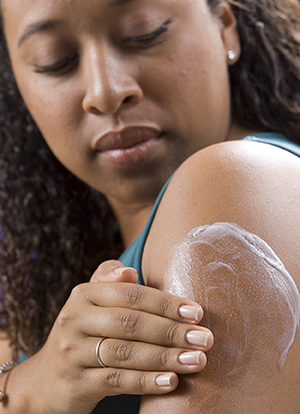Sunscreens: Protect Your Skin
What are sunscreens?
Sunscreens protect the skin. They play an important role in blocking ultraviolet (UV)
radiation from being absorbed by the skin. UV radiation damages the skin and can lead
to sunburns and skin cancer. No sunscreen blocks UV radiation 100%. But they allow
you to be outdoors for a longer time before your skin starts to redden. Using sunscreen
doesn't mean you can stay out in the sun for an unlimited amount of time. Damage to
your skin cells is still occurring.

What does the sun protection factor (SPF) mean?
Most skin cancers are caused by too much exposure to ultraviolet (UV) rays. The sun
protection factor (SPF) on a sunscreen label is a measure of how well the sunscreen
protects against UV rays. As the SPF value increases, sunburn protection increases.
Higher SPF numbers mean greater protection from UV rays. But no sunscreen can block
all UV rays.
How to select a sunscreen
A sunscreen protects from sunburn and reduces suntan by absorbing or reflecting UV
rays. Selecting a good sunscreen is important in protecting the skin. Choose a sunscreen
that offers:
-
Broad-spectrum protection. This protects against both UVA and UVB rays.
-
An SPF of 30 or higher
-
Water resistance or is waterproof. This means the sunscreen provides protection while
swimming or sweating for a certain amount of time—either 40 or 80 minutes, depending
on the label.
The best type of sunscreen is the one that offers the benefits above. The type or
brand you use is your choice. Sunscreen is available in lotions, creams, gels, ointments,
wax sticks, and sprays. Just be aware that different sunscreens contain different
ingredients. Stay away from products that have ingredients that can irritate your
skin.
How to apply sunscreen
Even when people use sunscreen, they often don't apply enough of it or don't apply
it correctly. This limits how useful it is. Follow these guidelines:
-
Apply sunscreen to all areas of skin that will not be covered by clothing.
-
Use at least 1 ounce of sunscreen (enough to fill a shot glass) to cover exposed areas.
An ounce should cover the whole body. But you might need to adjust the amount depending
on your body size and body hair.
-
Apply the sunscreen to dry skin about 15 to 30 minutes before going outdoors. This
gives it time to be absorbed.
-
Reapply sunscreen at least every 2 hours, or more often after swimming or sweating.
-
Protect your lips by applying a lip balm or lipstick that contains sunscreen with
an SPF of 30 or higher.
Remember that children need protection from the sun, too. Sunscreens are recommended
for everyone over 6 months of age. For babies younger than 6 months, the American
Academy of Pediatrics approves of the use of sunscreen only if adequate clothing and
shade are not available. Parents should still try to keep young babies away from sun
exposure, especially out of direct sunlight. Dress a baby in lightweight clothing
that covers most surface areas of skin. Parents also may apply a small amount of sunscreen
to exposed areas, such as baby’s face and back of the hands.
Don't rely on sunscreen alone
Using sunscreen when you are going out in the sun is important. But it is only one
part of an overall plan to protect your skin from harmful UV rays. Other important
ways to protect your skin include:
-
Seek shade when appropriate. Limit your sun exposure between 10 a.m. and 4 p.m., when
UV rays are the strongest.
-
Wear a hat with a wide brim and tightly woven clothing that covers most of your skin,
as well as sunglasses.
-
Don't use tanning beds or sunlamps.